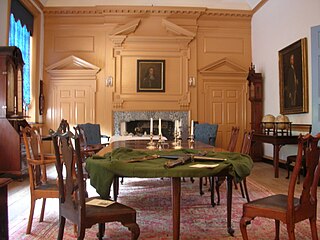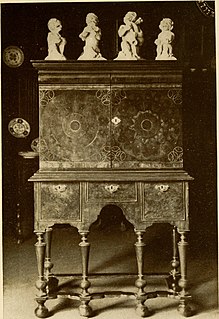
Furniture refers to movable objects intended to support various human activities such as seating, eating (tables), and sleeping. Furniture is also used to hold objects at a convenient height for work, or to store things. Furniture can be a product of design and is considered a form of decorative art. In addition to furniture's functional role, it can serve a symbolic or religious purpose. It can be made from many materials, including metal, plastic, and wood. Furniture can be made using a variety of woodworking joints which often reflect the local culture.

One of the basic pieces of furniture, a chair is a type of seat. Its primary features are two pieces of a durable material, attached as back and seat to one another at a 90°-or-slightly-greater angle, with usually the four corners of the horizontal seat attached in turn to four legs—or other parts of the seat's underside attached to three legs or to a shaft about which a four-arm turnstile on rollers can turn—strong enough to support the weight of a person who sits on the seat and leans against the vertical back. The legs are typically high enough for the seated person's thighs and knees to form a 90°-or-lesser angle. Used in a number of rooms in homes, in schools and offices, and in various other workplaces, chairs may be made of wood, metal, or synthetic materials, and either the seat alone or the entire chair may be padded or upholstered in various colors and fabrics.

Crathes Castle is a 16th-century castle near Banchory in the Aberdeenshire region of Scotland. This harled castle was built by the Burnetts of Leys and was held in that family for almost 400 years. The castle and grounds are owned and managed by the National Trust for Scotland and are open to the public.

A rocking chair or rocker is a type of chair with two curved bands attached to the bottom of the legs, connecting the legs on each side to each other. The rockers contact the floor at only two points, giving the occupant the ability to rock back and forth by shifting their weight or pushing lightly with their feet. Rocking chairs are most commonly made of wood. Some rocking chairs can fold.
Chairs are known from Ancient Egypt and have been widespread in the Western world from the Greeks and Romans onwards. They were in common use in China from the twelfth century, and were used by the Aztecs.

A curule seat is a design of a (usually) foldable and transportable chair noted for its uses in Ancient Rome and Europe through to the 20th century. Its status in early Rome as a symbol of political or military power carried over to other civilizations, as it was also used in this regard by kings in Europe, Napoleon, and others.

An X-chair is a chair with an X-shaped frame. It was known to have been used in Ancient Egypt, Rome, and Greece.

A Windsor chair is a chair built with a solid wooden seat into which the chair-back and legs are round-tenoned, or pushed into drilled holes, in contrast to standard chairs. The seats of Windsor chairs were often carved into a shallow dish or saddle shape for comfort. Traditionally, the legs and uprights were usually turned on a pole lathe. The back and sometimes the arm pieces are formed from steam bent pieces of wood.

A sgabello is a type of stool typical of the Italian Renaissance. An armchair with armrests usually was a chair (sedia) of hieratic significance. Sgabelli were typically made of walnut and included a variety of carvings and turned elements. The legs could be either two decorated boards with a stretcher for support, or three separate ornamented and carved impost legs. This seat was often placed in hallways, carved with a family's imprese or emblem drawn from its coat-of-arms. Its primary purpose was decorative, therefore the seat was not necessarily comfortable. Similar chairs were made in France, where they were known as a side chair. These had solid supports called rhombus seat supports. They were not used as stools.
Alexander Burnett, 12th Laird of Leys was a Scottish landowner.

The Queen Anne style of furniture design developed before, during, and after the time of Queen Anne, who reigned from 1702 to 1714.

The Nationality Rooms are a collection of 31 classrooms in the University of Pittsburgh's Cathedral of Learning depicting and donated by the national and ethnic groups that helped build the city of Pittsburgh. The rooms are designated as a Pittsburgh History and Landmarks Foundation historical landmark and are located on the 1st and 3rd floors of the Cathedral of Learning, itself a national historic landmark, on the University of Pittsburgh's main campus in the Oakland neighborhood of Pittsburgh, Pennsylvania, United States. Although of museum caliber, 29 of the 31 rooms are regularly used as functional classrooms that are utilized daily by University of Pittsburgh faculty and students, while the other two are mostly used as display rooms viewed through glass doors and are otherwise utilized primarily for special events and can only be explored via special guided tour. The Nationality Rooms also serve in a vigorous program of intercultural involvement and exchange in which the original organizing committees for the individual rooms remain as participants and includes a program of annual student scholarship to facilitate study abroad. In addition, the Nationality Rooms inspire lectures, seminars, concerts exhibitions, and social events which focus on the various heritages and traditions of the nations represented. The various national, traditional, and religious holidays of the nations represented are celebrated on campus and the rooms are appropriately decorated to reflect these occasions. The Nationality Rooms are available daily for public tours as long as the particular room is not being used for a class or other university function.

Daniel Pabst was a German-born American cabinetmaker of the Victorian Era. He is credited with some of the most extraordinary custom interiors and hand-crafted furniture in the United States. Sometimes working in collaboration with architect Frank Furness (1839–1912), he made pieces in the Renaissance Revival, Neo-Grec, Modern Gothic, and Colonial Revival styles. Examples of his work are in the collections of the Metropolitan Museum of Art, the Philadelphia Museum of Art, the Art Institute of Chicago, and the Victoria and Albert Museum in London.

A stool is one of the earliest forms of seat furniture. It bears many similarities to a chair. It consists of a single seat, for one person, without back or armrests, on a base of a stool there are either one, two, three or four legs. A stool is generally distinguished from chairs by their lack of arms and a back. Variants exist with one, two or five legs and these various stools are referred to by some people as "backless chairs". Some modern stools have backs. Folding stools can become flat, typically by rotating the seat to be parallel with fold-up legs.

Furniture created in the Art Nouveau style was prominent from the beginning of the 1890s to the beginning of the First World War in 1914. It characteristically used forms based on nature, such as vines, flowers and water lilies, and featured curving and undulating lines, sometimes known as the whiplash line, both in the form and the decoration. Other common characteristics were asymmetry and polychromy, achieved by inlaying different colored woods.

What later came to be known as the William and Mary style is a furniture design common from 1700 to 1725 in the Netherlands, the Kingdom of England, the Kingdom of Scotland, Kingdom of Ireland and later, in England's American colonies. It was a transitional style between Mannerist furniture and Queen Anne furniture. Sturdy, emphasizing both straight lines and curves, and featuring elaborate carving and woodturning, the style was one of the first to imitate Asian design elements such as japanning.

The furniture of the Louis XV period (1715-1774) is characterized by curved forms, lightness, comfort and asymmetry; it replaced the more formal, boxlike and massive furniture of the Louis XIV style. It employed marquetry, using inlays of exotic woods of different colors, as well as ivory and mother of pearl.

Louis XVI furniture is characterized by elegance and neoclassicism, a return to ancient Greek and Roman models. Much of it was designed and made for Queen Marie Antoinette for the new apartments she created in the Palace of Versailles, Palace of Fontainebleau, the Tuileries Palace, and other royal residences. The finest craftsmen of the time, including Jean-Henri Riesener, Georges Jacob, Martin Carlin, and Jean-François Leleu, were engaged to design and make her furniture.

Furniture and furnishings in early modern and late medieval Scotland were made locally or imported, mostly from Flanders and France. Although few pieces of furniture survive from the early part of the period, a rich vocabulary and typology is preserved in inventories and wills. This documentary evidence in the Scots language details the homes of the wealthy and aristocratic.


















